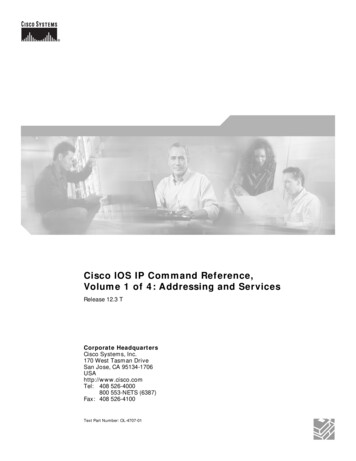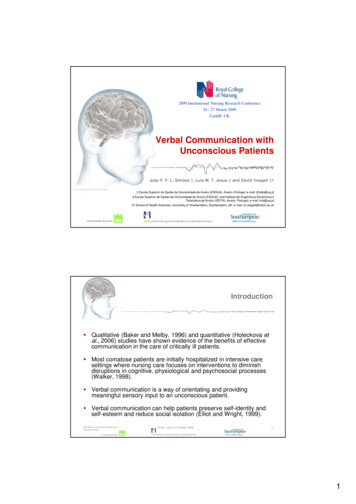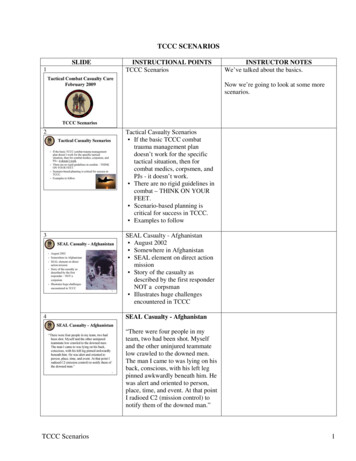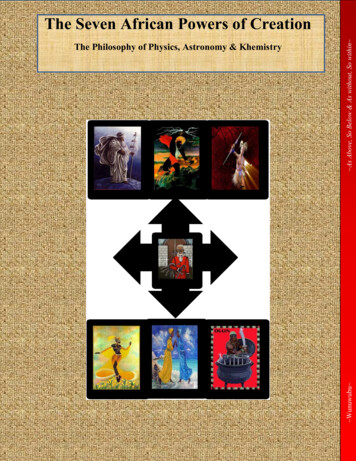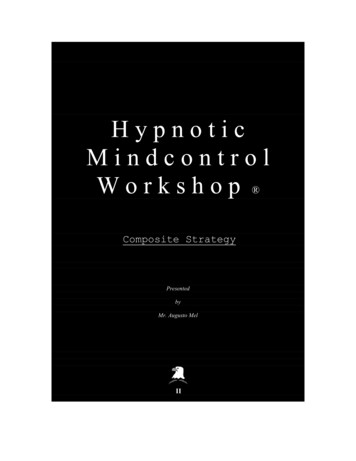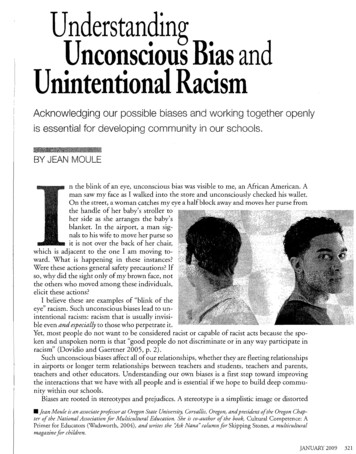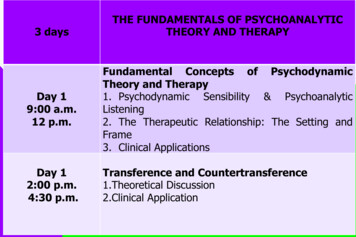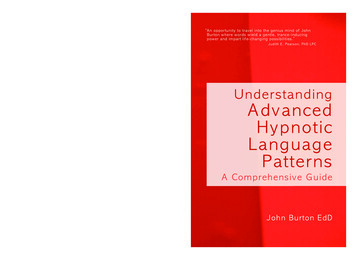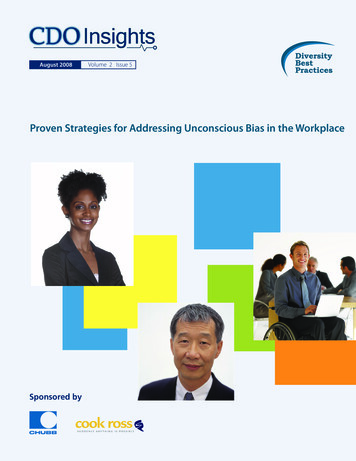
Transcription
August 2008Volume 2 Issue 5Proven Strategies for Addressing Unconscious Bias in the WorkplaceSponsored by
Testing Your OwnUnconscious BiasThe most effective tool available fortesting one’s own unconscious biasis the Implicit Association Test (IAT),created and maintained by ProjectImplicit, a consortium made up ofresearchers from Harvard University,the University of Virginia, and theUniversity of Washington. The IATwas created more than 10 years agoand has now been used by millionsof people in over 20 countries.Researchers at these three schools, aswell as others, have used the test tostudy many aspects of organizationaland social performance, ranging fromhealthcare decisions to the operationsof the criminal justice system. To takethe IAT, without charge, go to https://implicit.harvard.edu/implicit/.Exploring Unconscious Biasby Howard Ross, Founder & Chief Learning Officer, Cook Ross, Inc.Consider this: Less than 15% of American men are over six foot tall, yet almost60% of corporate CEOs are over six foot tall. Less than 4% of American menare over six foot, two inches tall, yet more than 36% of corporate CEOs are oversix foot, two inches tall.1 Why does this happen? Clearly corporate boards ofdirectors do not, when conducting a CEO search, send out a message to “get usa tall guy,” and yet the numbers speak for themselves. In fact, when corrected forage and gender, an inch of height is worth approximately 789 per year in salary!2Similar patterns are true for Generals and Admirals in the Military, and evenfor Presidents of the United States. The last elected President whose height wasbelow average was William McKinley in 1896, and he was “ridiculed in the pressas ‘a little boy.’” 3It seems not only unfair, but patently absurd to choose a CEO because of height,just like it is unfair and absurd to give employees lower performance evaluationssolely because they are overweight. Or to prescribe medical procedures to peoplemore often because of their race. Or to treat the same people different waysbecause of their clothing. Or even to call on boys more often than girls when theyraise their hands in school. And yet, all of these things continuously happen, andthey are but a small sampling of the hundreds of ways we make decisions everyday in favor of one group, and to the detriment of others, without even realizingwe’re doing it.1 Malcolm Gladwell discusses this phenomenon in his book, Blink, based on research conducted byTimothy Judge and Daniel Cable.2 Judge, Timothy A., and Cable, Daniel M., “The Effect of Physical Height on Workplace Success andIncome,” Journal of Applied Psychology, June 2004, p. 4353 Judge, Timothy A., and Cable, Daniel M., “The Effect of Physical Height on Workplace Success andIncome,” Journal of Applied Psychology, June 2004, p. 428 2008 Diversity Best Practices www.diversitybestpractices.com1
Lately, the concept of unconscious bias or “hidden bias” has come into the forefront of our work as diversity advocates because thedynamics of diversity are changing as we enter the 21st Century. Our tradition paradigm has generally assumed that patterns ofdiscriminatory behavior in organizations are conscious; that people who know better do the right thing, and those who don’t causebias. As a result, we have developed a “good person/bad person” paradigm of diversity: a belief that good people are not biased, butinclusive, and that bad people are the biased ones.One of the core drivers behind the work of diversity and inclusion professionals, almost since the inception of the first corporatediversity efforts, has been to find the “bad people” and fix them; to eradicate bias. There is good reason for this. If we are going tocreate a just and equitable society, and if we are going to create organizations in which everybody can have access to their fair measureof success, it clearly is not consistent for some people to be discriminated against based on their identification with a particular group.Also, clear examples of conscious bias and discrimination still exist, whether in broader societal examples like the recent incidents inJena, Louisiana, or in more specific organizational examples.Driven by this desire to combat inequities, we have worked hard through societal measures, like civil and human rights initiatives,to reduce or eliminate bias. We have put a lot of attention on who “gets” diversity, without realizing that to a degree our approachhas been self-serving and even arrogant. “If they were as (wise, noble, righteous, good, etc.) as us, then they would ‘get it’ like we do!”Usually this is based on the notion that people make choices to discriminate due to underlying negative feelings toward some groupsor feelings of superiority about their own. There is no doubt that this is often true. But what if, more times than not, people makechoices that discriminate against one group and in favor of another, without even realizing that they are doing it, and, perhaps evenmore strikingly, against their own conscious belief that they are being unbiased in their decision-making? What if we can make thesekinds of unconscious decisions even about people like ourselves?The problem with the good person/bad person paradigm is two-fold: it virtually assures that both on a collective and individual basiswe will never “do diversity right” because every human being has bias of one kind or another. Secondly, it demonstrates a lack ofunderstanding of a reality: human beings, at some level, need bias to survive. So, are we biased? Of course. Virtually every one of us isbiased toward something, somebody, or some group.The concept of the unconscious was, of course, Freud’s primary gift to the science of the mind, and, while it is not the purpose of thispaper to delve too deeply into the esoteric, this concept drove the development of modern psychology. Yet, as behavioral psychologymoved into the forefront during the 50’s, 60’s, and 70’s, the study of the unconscious became de-emphasized. Recent research, drivenlargely by our ability to now manage huge quantities of data, and new exploratory techniques have given us an ability to not onlyobserve the unconscious, but also to track and quantify its impact.We now have a vast body of research, conducted at some of our finest institutions of learning – Harvard, Yale, the University ofWashington, the University of Virginia, MIT, Tufts, and the University of Illinois, among others – that is showing us the same thing:unconscious or hidden beliefs – attitudes and biases beyond our regular perceptions of ourselves and others – underlie a great deal ofour patterns of behavior about diversity.The Necessary Purpose of BiasLet’s begin our exploration here by trying to understand the purpose of bias. We go out in the world every day and make decisionsabout what is safe or not, what is appropriate or not, and so on. This automatic decision making is what psychologist Joseph LeDouxhas suggested is an unconscious “danger detector” that determines whether or not something or someone is safe before we can evenbegin to consciously make a determination.4 When the object, animal, or person is assessed to be dangerous, a “fight or flight” fearresponse occurs.4 LeDoux, J. The Emotional Brain: The Mysterious Underpinnings of Emotional Life, New York: Simon and Schuster 2008 Diversity Best Practices www.diversitybestpractices.com2
On a conscious level, we may correct a mistake in this “danger detector” when we notice it. But often, we simply begin to generatereasons to explain why it was accurate to begin with. We are generally convinced that our decisions are “rational,” but in reality mosthuman decisions are made emotionally, and we then collect or generate the facts to justify them. When we see something or someonethat “feels” dangerous, we have already launched into action subconsciously before we have even started “thinking.” Our sense ofcomfort or discomfort has already been engaged.From a survival standpoint this is not a negative trait. It is a necessary one. We have all heard the axiom, “it is better to be safe thansorry,” and to a large degree this is true. If you sense something coming at your head, you duck. And if later you find out it was only ashadow of a bird flying by the window, better to have ducked and not needed to than to ignore the shadow and later find out it wasa heavy object!Where people are concerned, these decisions are hard-wired into us. At earlier times in our history, determining who, or what, wascoming up the path may have been a life or death decision. If it was a hostile animal, or a hostile tribe member, you might die. Ourminds evolved to make these decisions very quickly, often before we even “thought about it.”Our fundamental way of looking at and encountering the world is driven by this “hard-wired” pattern of making unconsciousdecisions about others based on what feels safe, likeable, valuable, and competent. Freud knew that the unconscious was far vasterand more powerful than the conscious. He described it as an iceberg: far more under the surface than above. Yet, recent researchindicates that even Freud may have underestimated the unconscious. As Timothy Wilson, a University of Virginia psychologist whohas studied the subject extensively has written: “According to the modern perspective, Freud’s view of the unconscious was far toolimited. When he said that consciousness is the tip of the mental iceberg, he was short of the mark by quite a bit – it may be more thesize of a snowball on top of that iceberg.”5Scientists estimate that we are exposed to as many as 11 million pieces of information at any one time, but our brains can onlyfunctionally deal with about 40. So how do we filter out the rest? How is it that we can walk down a busy street in New York City witha virtual ocean of stimulus in front of us and still look for a specific person or thing? How can we have a conversation with a friend inthe middle of thousands of people at a rock concert? We do it by developing a perceptual lens that filters out certain things and letsothers in, depending upon certain perceptions, interpretations, preferences and, yes, biases that we have adapted throughout our life.We can see this in some very mundane ways: if you or your partner was pregnant, did you notice how many more pregnant womenyou saw all of a sudden? If you were looking for a new car, how often did you suddenly start to see that car in commercials and on thestreet? Our perceptive lens enables us to see certain things and miss others, depending on the focus of our unconscious. It filters theevidence that we collect, generally supporting our already held points-of-view and disproving points of view with which we disagree.As a result of these pre-established filters, we see things, hear things, and interpret them differently than other people might. Or wemight not even see them at all! In fact, our interpretations may be so far off that we have to question, how do we know what is realanyway?5 Wilson, Timothy, Strangers to Ourselves 2008 Diversity Best Practices www.diversitybestpractices.com3
IN FOCUSThe Diversity of Language: An IntroductionThe language of diversity makes people uncomfortable. Words like discrimination, oppression, dominance, subordination,heterosexism, racism or male privilege often cause negative reactions. When people speak these words, others begin to focus onwhat it means for them. It is easier to become defensive, argue the meaning or ignore these interactions than it is to learn howthe language of diversity affects others and impacts all aspects of our lives. And, if we can’t talk productively about something,then we can’t do anything about it.American English is saturated with “the language of oppression,” which is perpetuated by a lack of awareness andunderstanding of language as an instrument of oppression. For any change to occur we must find a way to deal with the painand discomfort caused by certain terms and concepts. This is no easy task since the discomfort is rooted in our long historyof discriminatory attitudes and practices. We need to recognize that the words that carry a charge present an opportunityfor learning and change. Heterosexism isn’t a word that accuses “heterosexual” people of being bad, just as “disadvantaged”doesn’t refer to someone who is helpless. Used responsibly, these and other words can help us to understand issues and respondin a way that causes positive change for everyone.Since we have all learned the terminology of oppression simultaneously with learning the English language, we cannot unlearnit without making a conscious effort. The Diversity Factor Language Guide, from which this introduction is excerpted, is anaid in the unlearning process. While not definitive, it represents what we have learned about communicating the dynamics ofoppression. It focuses on the meaning and impact of group identities, including race, gender, ethnicity, sexual orientation andableness. To support those interested in relearning, here are some general principles: Notice your defensiveness and accept the discomfort of unlearning and relearning. To be competent in this arena is the sameas learning to be competent in anything else. It requires a desire to know, motivation to become informed, opportunities topractice and the willingness to correct your mistakes. The best way to check the appropriateness of a term is to ask a member of the group being referred to while rememberingthat no one individual represents the entire group. People often collude in oppressing others by failing to challenge negative terminology about their own group and by usingsuch terminology when speaking about others. Not everyone in a particular identity group, or everyone at a particular time, will agree on the use of specific terms orexpressions. For example, many people of color prefer to be called Hispanic. Others identify with Latino/a. Still others prefer tobe called by their national origin, e.g., Cuban, Mexican, Colombian, etc. All speakers of a language are influenced by the dynamics of dominant and subordinated group membership. If you are awhite, heterosexual man, your experience of language will be different from a black woman or a gay Asian man. Humor is a familiar and treacherous trap. It is next to impossible to gauge what might offend someone or for others to knowyour intent. Speaking and writing appropriately is, in the main, easy. Consider: “Would I want someone to use a similar expression aboutme?” Negative language used within a given identity group about itself and its own members is very different from the samelanguage used by people outside the group—though such usage is also often objectionable to group members.While the language of oppression is still with us, new words continue to emerge that are more accurate and descriptive, andallow us to be more successful in ameliorating oppression and more productive in our interactions with each other. People whoapply their learning place themselves in a position to affect change in the world. If humankind can relearn the language ofdiversity, then we can relearn how to respect and treat each other with honor, dignity and love.Excerpt from The Diversity Factor Language Guide (Fifth Edition, tmlUsed by special permission of Elsie Y. Cross Associates, Inc. 2008 Diversity Best Practices www.diversitybestpractices.com4
Exercise of the UnconsciousSeven Stepsto Identifyand AddressUnconscious Bias1. Recognize that youhave biases.2. Identify what thosebiases are.3. Dissect your biases.4. Decide which ofyour biases you willaddress first.5. Look for commoninterest groups.6. Get rid of yourbiases.7. Be mindful of biaskick back.Look at the picture below of the two tables and see if you can determine which ofthe tops is bigger. Or are they the same size, the same shape?You probably would say: “Obviously they are not the same shape. The one on theleft is clearly narrower and longer than the one on the right.” Or is it?Now take a piece of paper and either cut out or trace the table top on the left.Then lay your cutout or tracing over the top of the table top on the right. Whichis bigger? That’s right, they are both identical.This picture was created by Roger Shepard, an Oxford and Stanford Universityprofessor.6 We all have seen some of these kinds of illusions over the years, inReaders Digest or e-mail exchanges, and we often refer to them as optical illusions.We would be more accurate describing them as cognitive illusions, because theillusory experience is not created by our eyes, but by our brain. As Shepard says,“Because we are generally unaware that we are imposing a perceptualinterpretation on the stimulus, we are generally unaware that our experiencehas an illusory aspect. The illusory aspect may only strike us after we areinformed, for example, that the sizes or shapes of lines or areas that appearvery unequal are, in fact identical in the picture.”7When we look at the picture, having no reason to assume that there is an illusionat play, we don’t even consider that we might be seeing something different thanwhat is obviously right in front of us. The problem is that it is not what is rightin front of us at all.6 Shepard, Roger, Mind Sights: Original Visual Illusions, Ambiguities, and Other Anomalies, NewYork: W. H. Freeman and Company, 1990, p. 487 Ibid, p. 46 2008 Diversity Best Practices www.diversitybestpractices.com5
“When we getconscious aboutmanaging diversity,we are “tuning in”to the indicatorsaround us that tellus everyone doesnot see the worldthe way we do.While we know thatintellectually, whenit plays out in adifference of opinion,a different response,or a different wayof being, behaving,dressing, talking-- you name it, weforget that everyoneis not ‘just like me.’It is at that momentthat we have to wakeup, realize we need tomanage the diversitythat is facing us andbegin by thinking,“OK, who is in this mixand what are theirperspectives?“Dr. M. Elizabeth Holmes,Executive Vice President& Chief Learning Officer,Roosevelt Thomas Consulting& Training, from “GettingConscious About ManagingDiversity”The bottom line? We make assumptions and determinations about what is realevery moment of every day. We sort out those 11 million pieces of information,we see what we see, and we believe that what we see is real. Only occasionallydo we realize how subjective those determinations are, and how much they areimpacted not by what is in front of us, but by what we interpret is in front of us,seen through our own lens on the world.The challenge is that even knowing that we are inherently biased, we may not beable to help ourselves. According to Shepard,“Because the inferences about orientation, depth, and length areprovided automatically by (our) underlying machinery, any knowledgeor understanding of the illusion we may gain at the intellectual levelremains virtually powerless to diminish the magnitude of the illusion.”8Our perception, in other words, is so deeply buried in our “underlying machinery,”our unconscious, that even knowing that it is there makes it difficult, or impossible,to see its impact on our thinking and on what we see as real.The Deep Impact of Unconscious Bias inthe WorkplaceNow, if all of this is about a silly illusion about a table, then who really cares? Butwhat if it determines whether or not you will hire the most qualified candidate fora job? Or give an employee a fair performance review? Or hire the right CEO?Where diversity is concerned, unconscious bias creates hundreds of seeminglyirrational circumstances every day in which people make choices that seem tomake no sense and be driven only by overt prejudice, even when they are not. Ofcourse, there are still some cases where people are consciously hateful, hurtful,and biased. These people still need to be watched for and addressed. But it isimportant to recognize that the concept of unconscious bias does not only applyto “them.” It applies to all of us.Each one of us has some groups with which we consciously feel uncomfortable,even as we castigate others for feeling uncomfortable with our own groups. Theseconscious patterns of discrimination are problematic, but, again, they pale incomparison to the unconscious patterns that impact us every day. Unconsciousperceptions govern many of the most important decisions we make and have aprofound effect on the lives of many people in many ways.8Ibid 2008 Diversity Best Practices www.diversitybestpractices.com6
SPECIAL CASE STUDYChubbChubb has built its solid reputation on one simple principle, “Never compromise integrity.” This principle captures the spirit ofChubb, and the property, casualty and specialty insurance provider applies this same standard in its approach to diversity andinclusion within its organization.According to Chubb, companies that perceive diversity as exclusively a moral imperative or societal goal are missing the largerpoint. Workforce diversity should be viewed as a competitive advantage and a business imperative, and only when companiesapproach diversity and inclusion in this way can they achieve a fully diverse and inclusive workforce.The company believes that diversity is all about finding and developing the best talent, creating an inclusive work environmentand achieving outstanding business results. Talent comes in many packages. The packages vary by race, age, gender, ethnicity,color, sexual orientation and disability. Diversity, for Chubb, is about recognizing, respecting and valuing these differences.But the company also appreciates that diversity is also about things that are not so tangible. Diversity is about differences inthinking styles, religious beliefs, education, socioeconomic status, and geographic location, among many variables.In a true effort to create an environment where all employees can realize their fullest potential and in which the company canbenefit from the competitive advantage diversity provides, Chubb offers trainings on various aspects of diversity, including howto recognize and address unconscious bias.The first step in tackling workplace bias is to provide an open channel of communication for employees. Kathy Marvel, whoserves as the company’s Chief Diversity Officer, shares that Chubb provides easy access to employee relations personnel viaa dedicated phone line called “Voice of the Employee.” Callers can confidentially discuss issues that may require furtherinvestigation.“In our leadership training program called the ‘Leadership Development Seminar,’ we have included a section on biases,” Marvelexplains. “This training allows participants to identify biases that they may hold and their impact on effective leadership.”During the past 18 months, Chubb has also piloted several versions of bias awareness training for its management teams.Additionally, “we have paired the bias awareness training with performance management training to help provide guidance onobjectively linking performance with business goals, while managing the challenges we may face due to unconscious biases wemay have,” Marvel states. “The combined performance management / bias awareness session seems to be most effective, andwe are determining how best to move forward with that format.”According to Marvel, any organization seeking to address unconscious bias discussions or training from within must do socarefully. “It may be misconstrued that an organization that is conducting bias training has uncovered biases in their practices,and this may make organizations reluctant to proceed with valuable training that may change behaviors. Each organizationmust assess that risk with their general counsel.”While the company has been participating in training, Marvel cautions that understanding and accepting one’s biases is not anovernight process, nor a comfortable one. “Providing both team dialogue and personal reflection time is crucial for successfulimplementation,” Marvel says. 2008 Diversity Best Practices www.diversitybestpractices.com7
The Résumé StudyA number of studies point directly to how unconscious decisions impact business decisions. Researchers at MIT and the Universityof Chicago have discovered that even names can unconsciously impact people’s decision-making.9 These researchers distributed 5,000resumes to 1,250 employers who were advertising employment opportunities. The résumés had a key distinction in them: some weremailed out with names that were determined to be “typically white,” others with names that were “typically black.” Every companywas sent four resumes: one of each race that was considered an “average” résumé and one of each race that was considered “highlyskilled.”Pre-interviews with company human resources employees had established that most of the companies were aggressively seekingdiversity, a fact that seems more likely to have them lean toward somebody with a name that suggests a black candidate. And yet,the results indicated something else was occuring. Résumés with “typically white” names received 50 percent more callbacks thanthose with “typically black” names. There was another striking difference. While the highly skilled “typically white” named candidatesreceived more callbacks than the average ones, there was virtually no difference between the numbers of callbacks received by highlyskilled versus average “typically black” named candidates. Even more strikingly, average “typically white” named candidates receivedmore callbacks than highly skilled “typically black” named candidates! 10The Affinity Bias ExampleUnconscious patterns can play out in ways that are so subtle they are hard to spot. Imagine, for example, that you are conducting aninterview with two people, we’ll call them Sally and John. John reminds you of yourself when you were younger, or of someone youknow and like. You have that sense of familiarity or “chemistry.” You instantly like him, and though you are not aware of why, yourmind generates justifications. (“He seems like a straightforward kind of guy. I like the way he ‘holds’ himself.”) You ask him the firstinterview question and he hems and haws a bit. After all, it’s an interview. He’s nervous. Because you feel an affinity toward him, youpick up on his nervousness. You want to put him at ease. You say, “John, I know it’s an interview, but there’s nothing to be nervousabout. Take a breath and let me ask the question again.” John nails it this time and he’s off and running to a great interview. The wholeinteraction took four seconds, yet it made a world of difference.Then you sit down with Sally. There is nothing negative about her, just no real connection. It is a very “business-like” interaction. Youask her the first question and she’s a little nervous too, but this time you don’t pick up on it. This interview moves forward, but notquite as well as John’s. The next day a co-worker asks you how the interviews went, and you respond: “John was great open, easyto talk to. I think he’ll be great with staff and clients.” And your reply about Sally? “She’s okay, I guess.” Your perceptions about theinterviews constitute your reality. You probably don’t even remember the four-second interaction that changed John’s entire interview.In fact, if somebody asks you, you would swear you conducted the interviews exactly the same way with the same questions. Your ownrole in influencing the outcomes was completely invisible to you, driven by your background of comfort with John.9 Bertrand, Marianne and Mullainathan, Sendhil, Are Emily and Greg More Employable than Lakisha and Jamal? A Field Experiment on Labor Market Discrimination,University of Chicago Graduate School of Business, NBER and CEPR; MIT and NBER, 200410 Bertrand, Marianne and Mullainathan, Sendhil, Are Emily and Greg More Employable than Lakisha and Jamal? A Field Experiment on Labor Market Discrimination,University of Chicago Graduate School of Business, NBER and CEPR; MIT and NBER, 2004 2008 Diversity Best Practices www.diversitybestpractices.com8
IN FOCUSMicro-Affirmations and Unconscious BiasMary P. Rowe, Ph.D., Adjunct Professor of Negotiation and Conflict Management at the Massachusetts Institute of Technology(MIT) Sloan School of Management.Micro-affirmations – apparently small acts, which are often ephemeral and hard-to-see, events that are public and private, oftenunconscious but very effective, which occur wherever people wish to help others to succeed.What Are Micro-Affirmations?Micro-affirmations are tiny acts of opening doors to opportunity, gestures of inclusion and caring, and graceful acts of listening.Micro-affirmations lie in the practice of generosity, in consistently giving credit to others – in providing comfort and supportwhen others are in distress, when there has been a failure at the bench, or an idea that did not work out, or a public attack.Micro-affirmations include the myriad details of fair, specific, timely, consistent and clear feedback that help a person build onstrength and correct weakness.I have come to believe that teaching and training about micro-affirmations may help an organization in several different ways:The first effect is obvious – appropriately affirming the work of another person is likely both to help that person do well, and tohelp him or her to enjoy doing well.The second effect is that consistent, appropriate affirmation of others can spread from one person to another – potentiallyraising morale and productivity. It helps everyone, men and women, people of color and Caucasians. It appears to beparticularly helpful for department heads, and anyone who is senior to another person, to “model” affirming behavior.The third effect is subtle, and deals with the point that it may be hard for a person to “catch” himself or herself unconsciouslybehaving inequitably. I may not always be able to “catch myself” behaving in a way that I do not wish to behave. But if I tryalways to af
Proven Strategies for Addressing Unconscious Bias in the Workplace August 2008 Volume 2 Issue 5 Sponsored by . One of the core drivers behind the work of diversity and inclusion professionals, almost since the inception of the first corporate diversity efforts, has been to f



